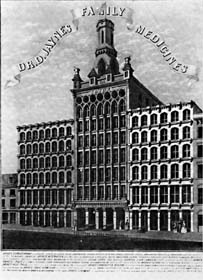Many of these images correspond to parts of the essay by Mr. Helfand and those sections are accessible through the link below the image.
| Deshler's Anti-Periodic Pills, a newly discovered and certain Cure for Fever & Ague. Chas. D. Deshler, Agent, New Brunswick, N. J. New York: Pudney & Russell, 1854. Broadside. This broadside was printed with eight different kinds of decorative wood types. in the essay |
 |
 |
Nancy Linton. A Faithful Representation of her Actual Appearance & Condition after having been Cured by the use of Swaim's Panacea. [London:] Drawn on stone by W.H. Kearney, printed by C. Hullmandel, [1830s?] Hand-colored lithograph. Swaim, one of the richest and boldest of the early medicine men, promoted his panacea with this hand-colored picture of his most famous cure. At first glance it looks like a "before" picture, but it is indeed an "after." Only Swaim's could have kept such a person alive, it suggests. Swaim claimed his panacea included no mercury, but it did, and Nancy Linton's condition suggests mercury poisoning. |
| Dr. Jayne's Family Medicines. Philadelphia: [ca. 1850.] Engraving. Jayne, one of the most flamboyant medicine men of the mid-19th century, made his headquarters into an advertisement by building it as tall as technology would then allow. This was in a sense the first American skyscraper. in the essay |
 |
 |
Shepherd's Medicines. Bodder & Co. proprietors, Baltimore. Philadelphia: Wagner & McGuigan. [ca. 1848.] Lithograph. in the essay |
| Dr. George Stuart's Botanical Syrup and Vegetable Pills, the Greatest Family Medicine in the World. Philadelphia: P. S. Duval, 1849. Lithograph. in the essay |  |
 |
Dr. C.F. Brown's Young American Liniment. Philadelphia: Duross Bros., 1861. Color woodcut and relief print. During the Civil War patriotism was used to promote an endless variety of products. Here color woodcut printing made a "before and after" illustration more effective. |
| Know Thyself! Lectures on Phrenology. New York: Office of the Phrenological Journal, S. R. Wells, Publisher, [ca. 1865]. Color woodcut and relief print. Phrenologists often corroborated their theories by referring to portraits of the heads of famous and infamous men and women. in the essay |  |
 |
Dr. Hoofland's Celebrated German Bitters and Balsamic Cordial. Prepared by Dr. C.M. Jackson. Philadelphia: L.N. Rosenthal, 1859. Chromolithograph. Chromolithography, lithography in colors, was introduced in the 1850s and revolutionized advertising posters. A riot of colors ensued, some more lifelike than others. |
| Green Mountain Boys Gathering Materials for Paine's Celebrated Green Mountain Balm of Gilead and Cedar Plaster. Boston: Forbes & Co., 1868. Lithograph. Advertisements often depicted the natural sources of proprietary medicines rather than the factories in which they were bottled. in the essay |
 |
 |
Dr. O. S. Martin. Read and Circulate, the Well Known and Popular Indian Physician, Dr. O. S. Martin, would respectfully inform the Ladies and Gentlemen of this place and vicinity that he has taken rooms at [blank filled in manuscript]. Schoharie, New York: "Republican" Power Press, 1860. Itinerant physicians often used handbills to announce their arrival in a town; they were printed with the location of the temporary office left blank so they could be used over and over again. An "Indian Physician" was a botanical doctor. in the essay |
| Jayne's Carminative Balsam. Philadelphia: D. Jayne & Son, 1857. Engraving in the essay |  |